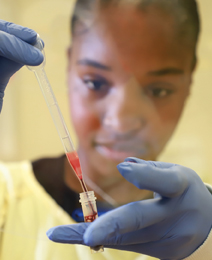The hidden scars of heart disease
One in 100 kids are born with heart disease—but some of them may not even know it
Many children who are born with a heart defect live with a physical scar. But for others, the scars can run much deeper—and the imprint they leave on the rest of a child’s life is profound.
In November 2019, 14-year-old Mattias was swimming in the hotel pool while on a school trip in Vancouver. As he dove into the water, his heart stopped beating, and he went into cardiac arrest—abruptly losing consciousness and his ability to breathe.
Two classmates noticed he was in trouble, and immediately pulled him out of the pool and began to administer CPR. Minutes later, paramedics arrived and revived him with an automated external defibrillator (AED), before rushing to BC Children’s Hospital, where Mattias went into cardiac arrest two more times. He spent the next week hooked up to a ventilator, as clinicians did everything possible to save his life.
A series of tests revealed that Mattias had a rare genetic heart condition called catecholaminergic polymorphic ventricular tachycardia (CPVT), which caused irregular heartbeats. While rare, the first sign of CPVT can be cardiac arrest. And if the heart isn’t brought back to its normal rhythm within minutes, it can be fatal.
Every year, hundreds of families in Canada are affected by the sudden death of a seemingly healthy child, who suddenly suffers from cardiac arrest without warning.
Stopping tragedy in its tracks
Fortunately, Mattias recovered and returned to his home near Kamloops a few weeks later. As an active teen with a passion for skiing and mountain biking, he’s been able to return to the activities he enjoyed before his diagnosis—but with notable differences. Mattias must take two medications daily for the rest of his life, without missing any doses.
 As Mattias was very keen to get back to the outdoors, he now carries a portable AED if he’s more than a ten-minute response time from paramedics or an on-site AED—and must be accompanied by someone who can administer CPR anytime he exercises.
As Mattias was very keen to get back to the outdoors, he now carries a portable AED if he’s more than a ten-minute response time from paramedics or an on-site AED—and must be accompanied by someone who can administer CPR anytime he exercises.
While his recovery has been remarkable, Mattias’ outcome would have been different if it wasn’t for the quick action taken by his classmates. CPR and rapid access to an AED are the most important measures to save the life of someone who is in cardiac arrest.
But now, through advances made in care, there is new hope for kids like him. “A lot of the heart conditions we treat at BC Children’s Hospital are inherited,” explained Dr. Shubhayan Sanatani.
“Through genetic testing, we can actually identify children who may have or be at risk of developing heart disease—often before they’ve even shown any symptoms.”
—Dr. Sanatani, division head of cardiology
 “This allows us to prevent the difficult and tragic consequences of heart rhythm disorders by getting treatments to children earlier,” he continues.
“This allows us to prevent the difficult and tragic consequences of heart rhythm disorders by getting treatments to children earlier,” he continues.
Even once genetic testing confirms the possibility of heart disease, many questions remain in determining the best treatment. With several possible medication combinations for heart arrhythmias, experts must often take a trial-and-error approach to find what is best for each child.
This poses a certain degree of risk because the wrong treatment can result in recurrent cardiac arrest or even worse, sudden death. For years, health care providers at BC Children’s have dared to ask: what if there was a better way?
Fighting heart disease in a dish
The answer to this question may lie in stem cells. As cells that are able to develop into many different cell types—including heart cells—they may hold the key to saving the lives of kids with heart rhythm disorders.
By taking a simple blood draw, researchers can turn a patient’s own blood cells into these stem cells, which are then transformed into beating heart cells that “come to life” in a petri dish. The heart cells contain the genome of each child, which enables experts to understand their unique condition in ways never before possible.
“While two children may have the same genetic mutation that’s causing a heart arrhythmia, one might go into cardiac arrest while another will be fine,” explained Dr. Glen Tibbits, an investigator at BC Children’s Hospital who is leading this work. “So, the idea is to screen children using their heart cells to understand who is at greatest risk with minimal discomfort for the child.”
“If a child is at risk, we can then test which medications will work—and which ones won’t—on those beating heart cells, before we use a treatment on them,” Dr. Sanatani added. “It’s a truly personalized approach to medicine.”
 Over the past several years, experts at BC Children’s Hospital have brought this innovative work to children who need it most. But the process of creating heart cells from blood cells not only requires a state-of-the-art facility, it also takes significant investments in time. As a result, many children who would benefit from stem cells haven’t been able to—yet.
Over the past several years, experts at BC Children’s Hospital have brought this innovative work to children who need it most. But the process of creating heart cells from blood cells not only requires a state-of-the-art facility, it also takes significant investments in time. As a result, many children who would benefit from stem cells haven’t been able to—yet.
Through generous support from Mining for Miracles—the BC mining industry’s long-standing fundraising campaign for BC Children’s Hospital Foundation—the hospital is on a quest to change this reality by establishing a Cellular and Regenerative Medicine Centre (CRMC). A first of its kind in Western Canada, the facility will enable experts to test more children at risk of sudden cardiac arrest, preventing tragic outcomes before they occur.
“Being at the forefront of new technology and knowledge is the key to improving health care,” explained Dr. Sanatani. “This centre will be a world-class platform for scientists and clinicians to come together to study patient conditions in the virtual labs that stem cells allow.”
